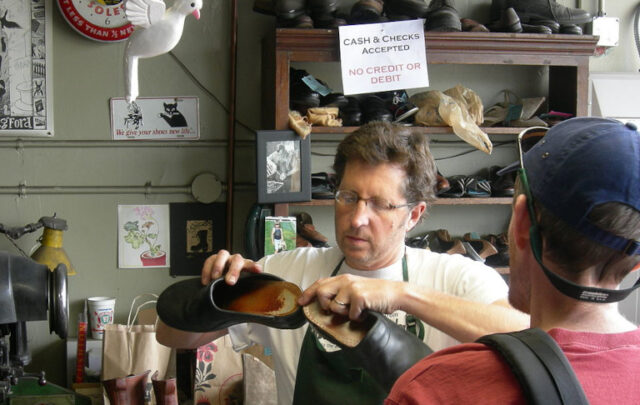Click on the headline (link) for the full text.
Many more articles are available through the Energy Bulletin homepage
Locus of Agency: Interview with Thomas Homer-Dixon
KMO, C-Realm
KMO talks with Thomas Homer-Dixon, author of The Upside of Down: Catastrophe, Creativity, and the Renewal of Civilization about the fragility of out vast centralized systems, the need for resiliency & diversity, and the possibilities for renewal and reinvention which only present themselves in historical moments of disintegration and collapse.
(30 May 2007)
Had to use Internet Explorer to hear this. For some reason, my Firefox browser didn’t work. The interview itself begins at about 9 minutes into the Podcast. -BA
Going ballistic: The hard facts about parabolic spikes
Doug Wakefield and Ben Hill, Financial Sense
Living through a mania is supposed to be a once in a lifetime event. For example, the French, who lived through the implosion of the Mississippi Scheme, and the English, who lived the South Sea Bubble collapse in the 1720s, did not see the same parabolic rises again during their lifetimes. Or for a more recent example, consider the parabolic rise of the Nikkei to its all time high in 1989, the aftermath of which has since changed the disposition of the Japanese toward their stock market.
… In his new book, The Black Swan, Nassim Nicholas Taleb expands on a concept he addressed in his first book, Fooled by Randomness. In the opening, Taleb addresses three attributes of the Black Swan:
“First, it is an outlier, as it lies outside the realm of regular expectations, because nothing in the past can convincingly point to its possibility. Second, it carries an extreme impact. Third, in spite of its outlier status, human nature makes us concoct explanations for its occurrence after the fact, making it explainable and predictable.”
And when we understand this concept, we realize why anticipating the rare event is critical, and that any model that does not address this risk is dangerously incomplete. Parabolic rises contain within themselves the warning of a price breakdown. As such, I strongly encourage you to help your clients and friends to stop extrapolating our current conditions into the indefinite future, and to stop repeating the phrase, “Well you have been saying that the markets were going to decline for a long time, and nothing has happened yet.” The real science of price movement and the pragmatic restrictions of debt overhang reveal the fallacy of such a mindset. But, emotions can cloud our judgment and make us rationalize the most reckless of actions.
(23 May 2007)
[More] or (Less)
Seth Godin, Blog
Many people are arguing for a fundamental change in the way humans interact with the world. This isn’t a post about whether or not we need smaller cars, local produce, smaller footprints and less consumption. It’s a post about how deeply entrenched the desire for more is.
More has been around for thousands of years. Kings ate more than peasants. Winning armies had more weapons than losing ones. Elizabeth Taylor had more husbands than you.
Car dealers are temples of more. The local Ford dealership lists four different models… by decreasing horsepower. Car magazines feature Bugattis, not Priuses on the cover. Restaurants usually serve more food (and more calories) than a normal person could and should eat.
Is this some sort of character flaw? A defective meme in the system of mankind? Or is it an evil plot dreamed up by marketers?
There’s no doubt that marketers amplify this desire, but I’m certain it’s been around a lot longer than Jell-O.
One reason that the litter campaign of the 1960s worked so well is that ‘not littering’ didn’t require doing less, it just required enough self control to hold on to your garbage for an hour or two. The achilles heel of the movement to limit carbon is the word ‘limit.’
It’s a campaign about less, not more. Even worse, there’s no orthodoxy. There’s argument about whether x or y is a better approach. Argument about how much is enough. As long as there’s wiggle room, our desire for more will trump peer pressure to do less. “Fight global warming” is a fine slogan, except it’s meaningless. That’s like dieters everywhere shouting, “eat less” while they stand in line to get bleu cheese dressing from the salad bar.
As a marketer, my best advice is this: let’s figure out how to turn this into a battle to do more, not less. Example one: require all new cars to have, right next to the speedometer, a mileage meter. And put the same number on an LCD display on the rear bumper. Once there’s an arms race to see who can have the highest number, we’re on the right track.
(21 May 2007)
Because we’re worth it
Bryan Appleyard, The Times Online
The baby-boomers’ culture of hedonistic consumerism has left their offspring with the crumbs from their table. And 65% of them say their children’s lives will be worse than their own. But are they bothered?
..Sally asked her mother what she should do for her summer holidays that would look good on her CV. “I flipped,” says Elisabeth. The brightly coloured 1960s of her youth had given way to the grim noughties of her children’s.
Elisabeth is not alone. The boomer generation is suddenly waking up to the terrible truth that their legacy to their children is a nastier, tougher and more anxious world than the one they knew. And the young are waking up to the fact that it has happened thanks to the unthinking greed of their parents. Battle lines are visible in the sand; an inter-generational war is brewing.
“When I speak to my parents,” says Daniel, Elisabeth’s 21-year-old son, a PhD student, “I hear stories of how they campaigned against war, government, for freedom of speech, etc. No one my age seems to believe that what they do will have any impact on how the world is run.”
Money offers them no hope of salvation. Pensions can’t be trusted and property prices have put houses beyond the reach of the young. ..
(27 May 2007)
See also Maxed out, spent down and busted.
Toxic Culture USA
Kalle Lasn and Richard DeGrandpre, AdBusters
…a number of provocative psychosocial studies have appeared that may rejuvenate this whole debate [about the battle of the “mental environment”]. These groundbreaking studies point to a growing toxicity in American culture. They suggest that cultural toxins have now reached dangerously high levels, helping to explain the high school shootings, the skyrocketing use of legal and illegal psychoactive drugs, our growing problems with obesity and psychosomatic illness, rage in public places, and the general sense of cynicism and hopelessness that is enveloping our culture.
Yet because these studies are so controversial, because they point an accusing finger at American culture and suggest that the “American Dream” itself may be one of the root causes of our deteriorating mental health, they remain in the margins – disputed, denied and ignored. So, as the journal of the mental environment, we figure it’s up to us to set things straight and give these studies the prominence they deserve. We surveyed 15 of them and in the following pages, offer brief synopses of the most compelling. Detailed summaries of all 15, with references and hyperlinks, can be read here.
This is fascinating, alarming, revolutionary stuff. Enough of this kind of research may finally politicize the mental environment the way Rachel Carson politicized the physical environment 30 years ago. See for yourself. Wade in, be skeptical, but don’t ignore the alarm bells in your head. This new evidence could transform you, if you haven’t already been transformed, into a mental environmentalist, fighting to stop pill-popping American spiritual emptiness from spreading across the globe.
(no date)
By clicking on the arrow at the bottom of the text, you can access the other parts of the series:
Culture Virus: The Mexico Study
A Growing Toxicity: Myra Weissman and the Cross-National Collaborative Group
Losing the Battle of the Mind: The W.H.O. Studies
Bibliography of Toxic Culture
-BA
Adam’s Story: Twilight in Learyville
John Michael Greer, The Archdruid Report
Last week’s Archdruid Report post introduced five themes likely to be primary factors shaping the deindustrial future before us. It’s easy to talk about such things in the abstract, but harder to make sense of them as a lived reality, and it’s this latter step that has to be taken to understand their impact on our world. For this reason I’ve picked up the toolkit of narrative fiction again. Each of the next five essays will be preceded by a fictional account of one person’s journey through a world shaped by the five themes I’ve mentioned. The story begins in the rural Pacific Northwest sometime in the second half of this century.
(28 May 2007)
See previous writings of John Michael Greer for the intellectual background of the story. -BA





